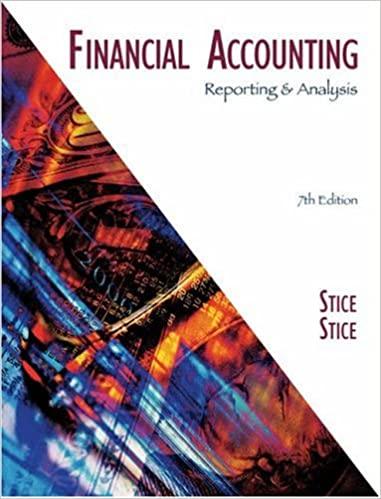Question
Alamo Inc. purchased 80 percent of the outstanding stock of Western Ranching Company, located in Australia, on January 1, 20X3. The purchase price in Australian
| Alamo Inc. purchased 80 percent of the outstanding stock of Western Ranching Company, located in Australia, on January 1, 20X3. The purchase price in Australian dollars (A$) was A$200,000, and A$40,000 of the differential was allocated to plant and equipment, which is amortized over a 10-year period. The remainder of the differential was attributable to a patent. Alamo Inc. amortizes the patent over 10 years. Western Ranchings trial balance on December 31, 20X3, in Australian dollars is as follows: |
| Debits | Credits | |||
| Cash | A$ | 44,100 | ||
| Accounts Receivable (net) | 72,000 | |||
| Inventory | 86,000 | |||
| Plant & Equipment | 240,000 | |||
| Accumulated Depreciation | A$ | 60,000 | ||
| Accounts Payable | 53,800 | |||
| Payable to Alamo Inc. | 10,800 | |||
| Interest Payable | 3,000 | |||
| 12% Bonds Payable | 100,000 | |||
| Premium on Bonds | 5,700 | |||
| Common Stock | 90,000 | |||
| Retained Earnings | 40,000 | |||
| Sales | 579,000 | |||
| Cost of Goods Sold | 330,000 | |||
| Depreciation Expense | 24,000 | |||
| Operating Expenses | 131,500 | |||
| Interest Expense | 5,700 | |||
| Dividends Paid | 9,000 | |||
| Total | A$ | 942,300 | A$ | 942,300 |
| Assume that the Australian dollar (A$) is the functional currency and that Alamo uses the fully adjusted equity method for accounting for its investment in Western Ranching. A December 31, 20X3, trial balance for Alamo Inc. follows. |
| Item | Debits | Credits | ||
| Cash | $ | 38,000 | ||
| Accounts Receivable (net) | 140,000 | |||
| Receivable from Western Ranching | 6,480 | |||
| Inventory | 128,000 | |||
| Plant & Equipment | 500,000 | |||
| Investment in Western Ranching | 152,064 | |||
| Cost of Goods Sold | 600,000 | |||
| Depreciation Expense | 28,000 | |||
| Operating Expenses | 204,000 | |||
| Interest Expense | 2,000 | |||
| Dividends Declared | 50,000 | |||
| Translation Adjustment | 22,528 | |||
| Accumulated Depreciation | $ | 90,000 | ||
| Accounts Payable | 60,000 | |||
| Interest Payable | 2,000 | |||
| Common Stock | 500,000 | |||
| Retained Earnings, January 1, 20X3 | 179,656 | |||
| Sales | 1,000,000 | |||
| Income from Subsidiary | 39,416 | |||
| Total | $ | 1,871,072 | $ | 1,871,072 |
| Additional Information: |
| 1. | Western Ranching uses average cost for cost of goods sold. Inventory increased by A$20,000 during the year. Purchases were made uniformly during 20X3. The ending inventory was acquired at the average exchange rate for the year. |
| 2. | Plant and equipment were acquired as follows: |
| Date | Cost | |||
| January 20X1 | A$ | 180,000 | ||
| January 1, 20X3 | 60,000 | |||
| 3. | Plant and equipment are depreciated using the straight-line method and a 10-year life with no residual value. |
| 4. | The payable to Alamo is in Australian dollars. Alamos books show a receivable from Western Ranching of $6,480. |
| 5. | The 10-year bonds were issued on July 1, 20X3, for A$106,000. The premium is amortized on a straight-line basis. The interest is paid on April 1 and October 1. |
| 6. | The dividends were declared and paid on April 1. |
| 7. | Exchange rates were as follows: |
| A$ | $ | |||||||||||||
| January 20X1 | 1 | = | 0.93 | |||||||||||
| August 20X1 | 1 | = | 0.88 | |||||||||||
| January 1, 20X3 | 1 | = | 0.70 | |||||||||||
| April 1, 20X3 | 1 | = | 0.67 | |||||||||||
| July 1, 20X3 | 1 | = | 0.64 | |||||||||||
| December 31, 20X3 | 1 | = | 0.60 | |||||||||||
| 20X3 average | 1 | = | 0.65 | |||||||||||
| ||||||||||||||
Step by Step Solution
There are 3 Steps involved in it
Step: 1

Get Instant Access to Expert-Tailored Solutions
See step-by-step solutions with expert insights and AI powered tools for academic success
Step: 2

Step: 3

Ace Your Homework with AI
Get the answers you need in no time with our AI-driven, step-by-step assistance
Get Started





